ITALY
Verona

Verona
Verona
 Piazza Bra in VeronaPhoto: Italo-Europeo CC 3.0 Unported no changes made
Piazza Bra in VeronaPhoto: Italo-Europeo CC 3.0 Unported no changes made
Verona is best known for serving as the backdrop for William Shakespeare's play Romeo and Juliet. There are a number of sights directly related to this such as the Montechi House (Romeo's house) and the balcony in the Casa di Guilietta. Verona has a beautiful old center with interesting buildings and squares, a cathedral, a fortress and several church buildings that are more than worth a visit. Historical highlights include the Roman arena, the 18th century Piazza Bra and the many surrounding palaces and the beautiful Renaissance garden, the Giardino Giusti, which Mozart is said to have walked there regularly.
Location
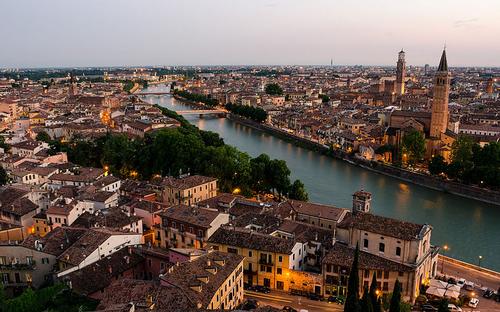 The Adige flows through VeronaPhoto: Luca Casartelli CC 2.0 Generic no changes made
The Adige flows through VeronaPhoto: Luca Casartelli CC 2.0 Generic no changes made
Verona is located in the north of Italy and is the capital of the province of the same name in the Veneto region. It is close to the Dolomites and can serve as a base for a trip to the lake district. Milan is east of Verona, Padua and Venice are west of the city. The Adige River flows through the city, there are many bridges connecting the city districts.
Weather
Spring can be very pleasant in Verona. You can expect nice weather with the occasional shower. In June, daytime temperatures can reach 24°C. The summer climate can sometimes feel stiflingly hot. As a result, sightseeing in the center could be tiring. During the day the temperature is usually around 28°C, but it often rises above 30°C. The humidity contributes to the feeling of warmth in the summer. September and October are often still fairly sunny months, although visitors can expect more showers. From the end of November to January and February, the weather and climate in Verona are mainly characterized by cool, crisp days with clear blue skies. During the day the temperature is between 0°C and 7°C on average.
The best periode to visit Verona is the spring or early autumn which have the best weather conditions.
History
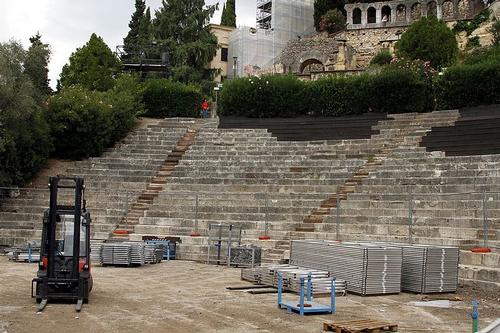 Ancient Roman Theater in VeronaPhoto: Jose Luis Bernardus Ribeiro CC 4.0no changes made
Ancient Roman Theater in VeronaPhoto: Jose Luis Bernardus Ribeiro CC 4.0no changes made
In 89 BC the Romans established a colony in Verona. It is easy to see why Verona was strategically interesting. The town sits on the banks of the River Adige at a point where it is easy to cross from one side to the other and the area is surrounded by hills. Verona grew rapidly and was even considered a miniature version of Rome. In its heyday, Verona had all the hallmarks of an important Roman city, including an arena, which dates back to the 1st century BC and can still be seen today. The fall of the Roman Empire in the 5th century AD left Verona without adequate military protection. Groups of barbarians invading plundered everything the Romans had left behind.
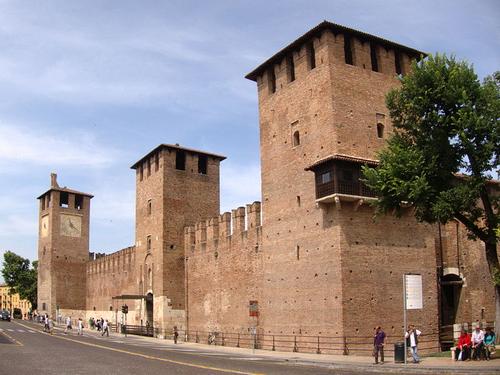 Castelvecchio in VeronaPhoto: AHert CC 3.0 Unported no changes made
Castelvecchio in VeronaPhoto: AHert CC 3.0 Unported no changes made
As in all Italian cities, life in medieval Verona was far from easy. Fierce internal rivalry led to political instability and frequent changes in governance. Around 1260, a powerful local family known as the della Scalas came to power and Verona flourished under their influence. They had a great love for the arts, and a member of this illustrious family known as Cangrande I was the protector of the famous Italian writer Dante. The della Scala family was eager to showcase their wealth and power, which is why many of the city's impressive buildings date from this period including the Castelvecchio. The legend of Romeo and Juliet also has its origins at this time.
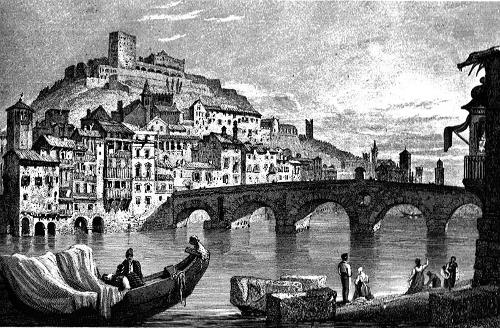 Etching of Verona in 1825Ets by J.T. Willmore after a drawing by Samuel Prout in the Public Domain
Etching of Verona in 1825Ets by J.T. Willmore after a drawing by Samuel Prout in the Public Domain
In 1405, during the Renaissance, Verona was incorporated into the Venetian Republic. The city was home to many wealthy merchants and nobility. They built palaces that reflected their prosperity and churches in which to pray. Verona presented itself in the cultural and artistic field. It also enjoyed some degree of economic success. The political status quo was broken by French soldiers under Napoleon, who occupied the city in 1796. Then, in 1814, Verona was annexed by the Habsburg Empire. In the 19th century, the city served as a defensive stronghold. In 1866, Verona became part of the Kingdom of Italy.
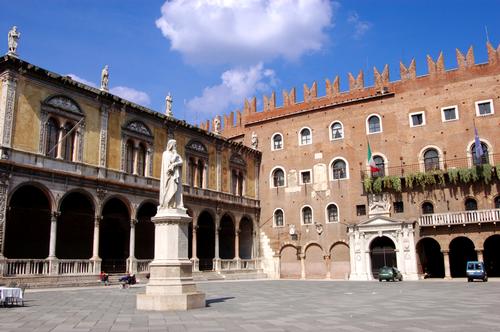 Piazza dei Signori in VeronaPhoto: Lo Scaligero CC 3.0 Unported no changes made
Piazza dei Signori in VeronaPhoto: Lo Scaligero CC 3.0 Unported no changes made
In the Second World War Verona suffered heavy attacks from Allied bombers. It was further damaged by German forces when they withdrew in 1945. In recent years Verona has further expanded its popularity as a busy tourist destination and the city is now an important UNESCO World Heritage Site.
Sights
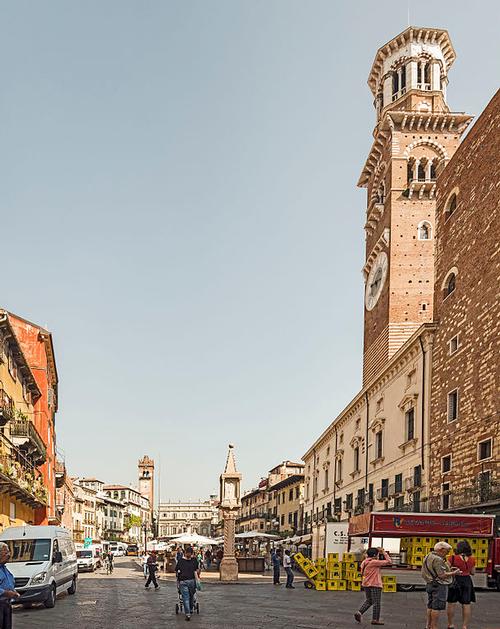 Piazza delle Erbe in VeronaPhoto: Didier Descouens CC 4.0 International no changes made
Piazza delle Erbe in VeronaPhoto: Didier Descouens CC 4.0 International no changes made
The Piazza delle Erbe has always played a central role in Verona's life. Today there is a lively market, with a small 14th century fountain in the center. In earlier times, this area was the actual site of the Roman Forum and the place where citizens went to watch horse races. Visitors will certainly not be able to miss Verona's most famous monument, aptly named 'Tower of the City', as it stands right in the middle of the Piazza delle Erbe and is 84 meters high. The tower's two bells used to call the council to their meetings and warn the citizens of fires have their own names - Marangona and Rengo.
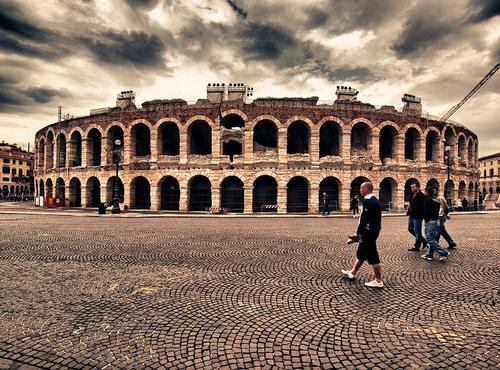 Verona ArenaPhoto: Kevin Poh CC 2.0 Generic no changes made
Verona ArenaPhoto: Kevin Poh CC 2.0 Generic no changes made
Verona's famous Roman Amphitheater is one of the best-preserved of its kind and is one of the city's main attractions. The amphitheater was built in AD 30 and could accommodate more than 20,000 people. It's incredible to just stand there and imagine what Roman life was like in real life. Even now the arena still welcomes thousands of visitors. However, they no longer come for the gladiatorial fights, but for more peaceful cultural events and operas. The acoustics are very good.
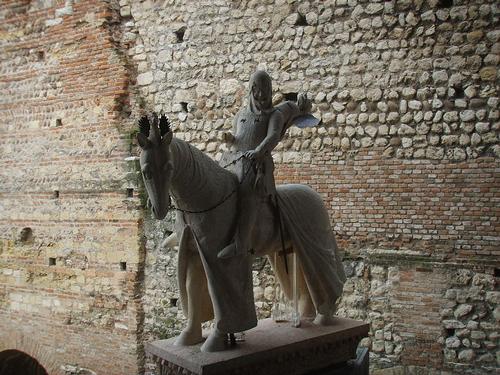 Statue Cangrande I in museum Castevecchio in VeronaPhoto: Sailko CC 3.0 Unported no changes made
Statue Cangrande I in museum Castevecchio in VeronaPhoto: Sailko CC 3.0 Unported no changes made
Castelvecchio is Verona's 'old castle' and it served once as a fortification to protect Verona from invading armies. It was also the castle of the noble Della Scala family. Today the castle is used as a museum. The building has been renovated in the signature style of architect Carol Scarpa. Like a number of other museums in Verona, the art museum in Castelvecchio was founded in the 1920s. The museum contains collections of sculptures, medieval canvases, but also weapons. The statue that used to stand above the grave of Cangrande I in the Scaglieri cemetery in Verona is now displayed in this Civico Museo d'Arte di Castelvecchio.
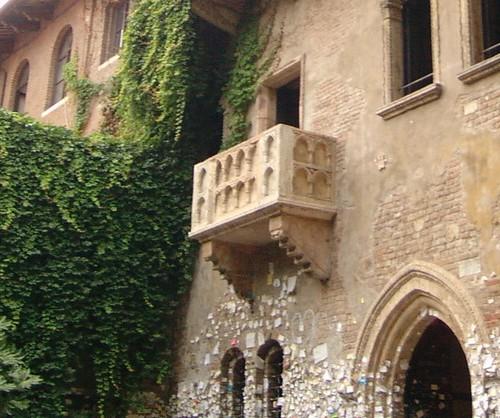 Balcony of Juliet in VeronaPhoto: Uwe Hermann CC 3.0 Unported no changes made
Balcony of Juliet in VeronaPhoto: Uwe Hermann CC 3.0 Unported no changes made
Few visitors to Verona can resist a visit to Juliet's house. Although Juliet is a purely fictional character, Shakespeare's love story remains a legend in the city. The balcony on which Julia is said to have spent many hours is the main attraction. The building itself dates back to the 12th century and was owned by the Dal Cappello family. The original medieval house was heavily restored in the last century and has become more or less what we see today, including the famous and therefore not authentic balcony, the Gothic door and paintings. There is a bronze statue of Juliet in the courtyard. When you touch her right breast you should be lucky in love.
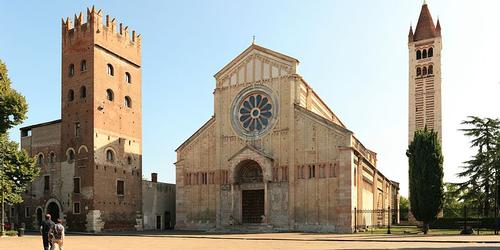 Basilca of Sint Zeno in VeronaPhoto: Ranhard Findling CC 3.0 Unported no changes made
Basilca of Sint Zeno in VeronaPhoto: Ranhard Findling CC 3.0 Unported no changes made
The Basilica of Saint Zeno is dedicated to the patron saint of Verona, Saint Zeno. His ashes would be kept in this basilica. As an example of Romanesque architecture, the building is unsurpassed in the city. The basilica has a large rose window, popularly known as the 'wheel of fortune'. It also has particularly beautiful bronze doors, best viewed from the interior of the church. A highlight is the Mantegna triptych that depicts the 'Madonna Enthroned in the midst of saints'. The original panels are located in the Louvre in Paris. There are also beautiful frescoes to see, including "the crucifixion" by the painter Altichiero.
Tips
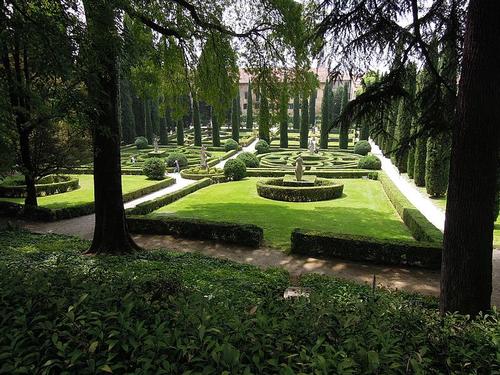 Giardino Giusti in VeronaPhoto: Dependability CC 4.0 International no changes made
Giardino Giusti in VeronaPhoto: Dependability CC 4.0 International no changes made
The Giardino Giusti is a remarkably well-preserved Renaissance garden that dates back to the late 16th century and was once home to the likes of Goethe and Mozart. There is plenty to see and do. You will see flower beds, an avenue of cypress trees, statues and fountains, a labyrinth, water features, romantic caves and even a spiral staircase. From the top, visitors can enjoy beautiful views of the city. The garden is just a short walk from the center. It is the perfect place to relax or enjoy a walk.
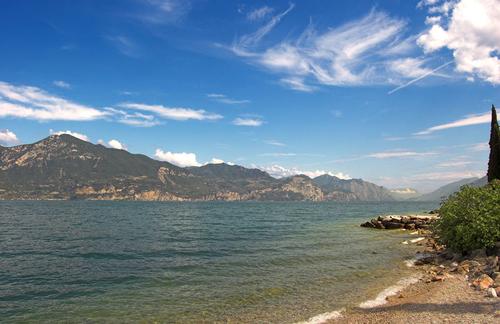 Lago di GardaPhoto: Lo Scaligero CC 3.0 Unported no changes made
Lago di GardaPhoto: Lo Scaligero CC 3.0 Unported no changes made
To the northwest of Verona is Lake Garda, the largest lake in Italy and a very popular holiday destination. The southern shoreline of the lake can be busy during the summer months, the surrounding hills and mountains are quieter, especially on the north side.
Useful links Verona
BBC Country ProfilesWorld Fact Book Explore all Countries
How to call
Last updated November 2025
Copyright: Team - The World of Info